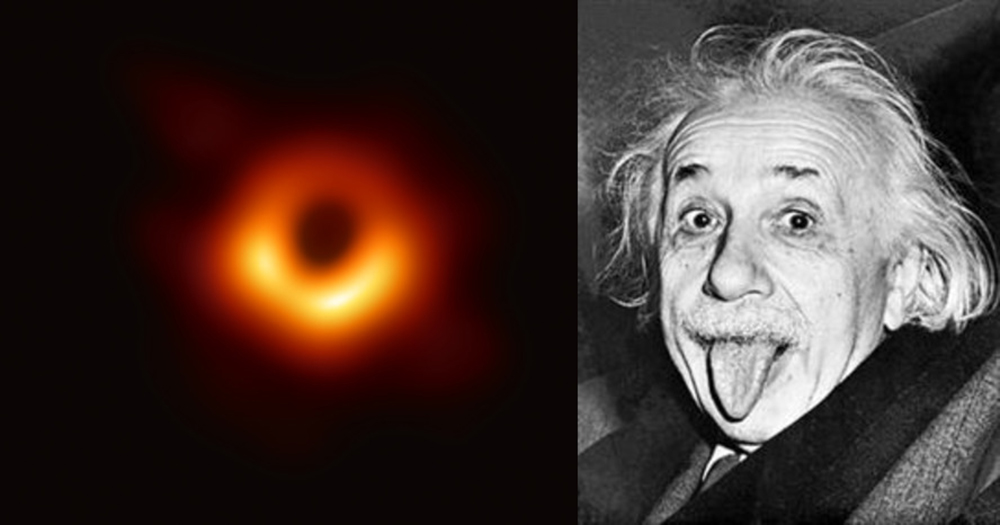For the first time in human history, astronomers have managed to take a photo of a black hole, located in a distant galaxy.
And it is absolutely massive.
Larger than The Solar System
Clocking in a measurement of 40 billion km across, or three million times the size of Earth, the black hole is larger than the entire Solar System, BBC reported.
In terms of mass, the black hole is 6.5 billion times that of our the Sun, with scientists speculating it as one of the heaviest black holes in the universe.
Distance-wise, the black hole is located in the galaxy Messier 87 (M87) 500 million trillion km away or 55 million light-years away.
As for the "ring of fire" you can see in the image, surrounding a circular hole, its the result of superheated gas falling into the hole, producing a light brighter than all the billions of other stars in M87 combined - which is why it can be seen at such distance from Earth.
With regard to the edge of the hole, this is known as the event horizon, the point by which gravity becomes so strong that not even light can escape.
And this is just the zoomed-in photo of the black hole.
To give you some sense of the black hole's immense scale, and the amount of matter it is consuming, here's how the black hole looks like when it is zoomed out, according to a photo taken by NASA’s Chandra X-ray Observatory.
As impressive (and maybe a little terrifying) as all of this sounds, of greater significance is that the photo also proves Albert Einstein's theories were right.
Specifically, his General Theory of Relativity.
Why does the photo prove Einstein was right?
Because prior to the discovery of black holes in 1971, Einstein's Relativity theory had already predicted them as the logical conclusion of his equations in 1916.
To paraphrase from The Conversation, Einstein's theory essentially postulated that matter follows the curvature of space, but because matter is also the source of gravity, the curvature of space responds to matter as well.
As such, in a scenario where there is a large amount of matter in a very small area, the curvature can become so strong that not even light can escape -- like a black hole.
Somewhat surprisingly, Einstein himself dismissed the idea that something could collapse in on itself forever, reaching a point of infinite density and curving space to the point that not even light could escape, Bloomberg reported.
In his own view, the scientist thought it was a concept that was a little too strange to manifest in reality and dismissed the "black hole" as a mathematical outcome.
How did the black hole form?
It is unknown, given its status as a supermassive black hole.
Typically, a black hole forms when a star that is more than three times our Sun's mass burns through the last of its fuel and collapses in on itself, compressing its matter into the size of a city (think four of our Suns being crammed into a space the size of Singapore).
This results in a very powerful gravitational field that pulls in objects around it such as the dust and gas from the surrounding galaxy. Such a black hole is known as a stellar black hole.
Supermassive black holes on the other hand, have been speculated to be either the result of hundreds or thousands of small black holes merging together, large clouds of gas collapsing in on themselves, or the result of a cluster of stars collapsing together.
How was the black hole photographed?
The black hole was photographed through the combined efforts of eight different radio telescopes located in six different locations -- Chile, Mexico, Spain, Hawaii, Arizona and the Antarctic -- which together, make up the Event Horizon Telescope endeavour, BBC reported.
This is because no telescope by itself is powerful enough to image the black hole.
200 scientists were involved in pointing the connected telescopes at galaxy M87 and scanning its centre for 10 days.
To top it off, the data gathered was too much to be sent over the Internet, which meant that it had to be stored on hard drives instead, that were then flown to processing centres in the US and Germany for assembly.
Event Horizon Telescope hopes to image the supermassive black hole in our own galaxy next
As for the next supermassive black hole that the Event Horizon Telescope is hoping to capture, it's the one within our very own galaxy, known as Sagittarius A*, both BBC and Time reported.
While it might seem paradoxical that the closer black hole has been the harder one to capture, much of this has to do with how Sagittarius A* is much smaller, relative to the M87 black hole.
At 26,000 light years from Earth, Sagittarius A* clocks in a width of roughly 40 million km, and a mass 4.1 million times that of our Sun.
This means that its brightness is much dimmer and therefore, harder to spot.
Top image collage from Event Horizon Telescope Facebook and Wikipedia
Content that keeps Mothership.sg going
??
Get 50% off your favourite dishes in Paradise Group's restaurants here.
??
Read this not just to accumulate good karma.
??
These people willingly clean up other people's trash. Find out why.
??
Next station, WELCOME TO UNIQLO! What is going on?
??
Find out where all your tax money is going.
If you like what you read, follow us on Facebook, Instagram, Twitter and Telegram to get the latest updates.
